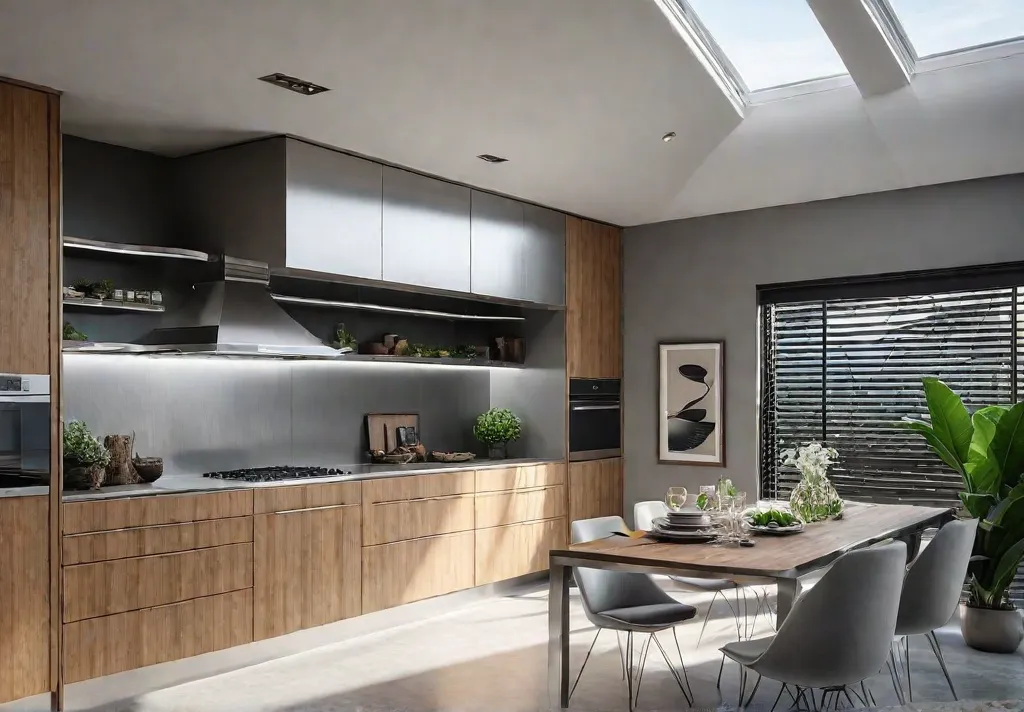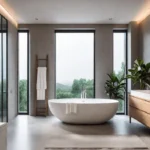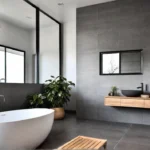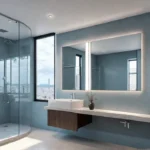In our modern world of excess and disposability, the choices we make for our homes carry profound weight. As we strive to tread more lightly on this earth, the kitchen – that sacred space where we nourish ourselves and gather with loved ones – becomes a canvas for embodying our sustainable values. By thoughtfully selecting eco-friendly materials that honor nature’s abundance, we can transform this heart of the home into a restorative sanctuary.

From the warmth of reclaimed wood to the organic allure of bamboo, the path to a contemporary yet conscious kitchen renovation is paved with a bounty of beautiful, renewable resources. Join me as we explore seven sustainable materials that seamlessly blend modern design with ancient wisdom, turning your culinary haven into a nurturing oasis in harmony with the world around us.
Bamboo: The Sustainable Superstar
Bamboo has rapidly become one of the most sought-after materials for contemporary kitchens, and it’s easy to see why. This versatile grass possesses an undeniable natural beauty while offering unparalleled sustainability credentials.
The Benefits of Bamboo
Unlike hardwood trees that can take decades to mature, certain bamboo species can grow up to an astonishing 3 feet per day. This rapid renewability makes bamboo an incredibly eco-friendly choice for kitchen renovations. It’s also naturally antimicrobial and hypoallergenic, adding another layer of practicality.
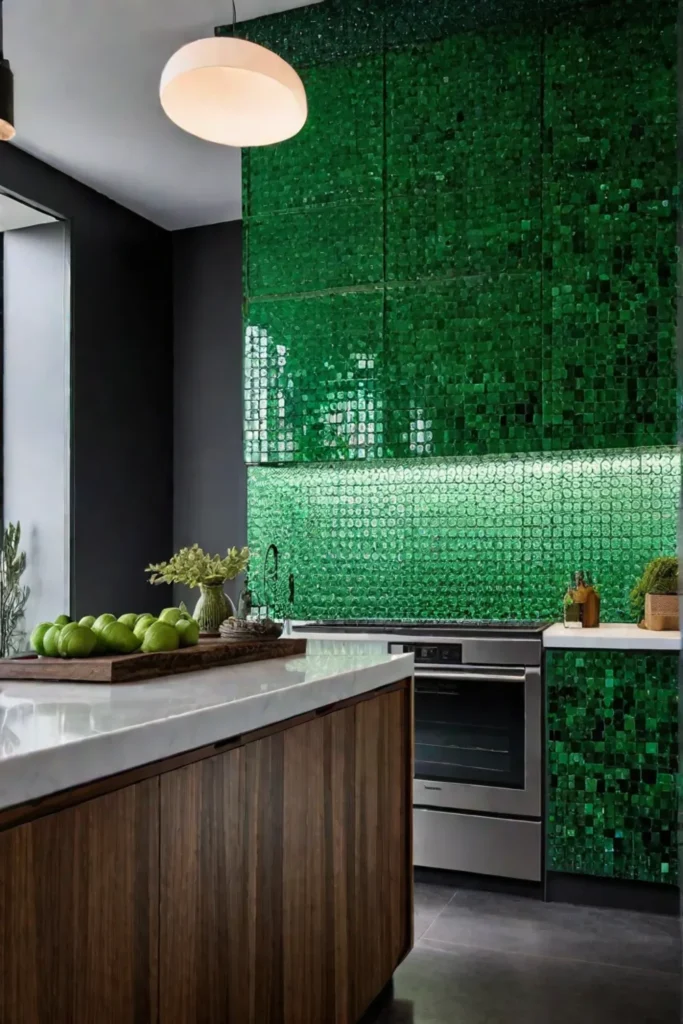
Beyond its sustainability, bamboo exudes a warm, organic aesthetic that brings an unmistakable sense of tranquility. Its subtle grain patterns and light hues create a serene ambiance, perfect for cultivating a restorative sanctuary in the heart of your home.
Incorporating Bamboo in Your Kitchen
The versatility of bamboo allows for seamless integration throughout your kitchen design. Consider bamboo flooring for a warm and inviting foundation, or opt for bamboo cabinets with low-VOC finishes for a healthier interior. Bamboo cutting boards and utensils offer a naturally antibacterial surface for food preparation.
When it comes to countertops, bamboo’s durability and resistance to moisture make it an ideal choice for the high-traffic kitchen environment. Its unique texture adds visual interest while providing a sturdy workspace for all your culinary creations.
Bamboo also lends itself beautifully to kitchen accessories, from sleek pendant lighting to stylish storage solutions. These touches of nature bring an organic flow to your design, fostering a sense of harmony between the indoors and out.
While bamboo may be slightly more expensive than some conventional materials, its long-lasting durability and sustainable nature make it a worthwhile investment for the conscious homeowner.
As you embark on your kitchen renovation, consider bamboo as a sustainable superstar that effortlessly combines eco-conscious living with contemporary style. By surrounding yourself with natural elements like this remarkable grass, you can create a restorative sanctuary that nourishes both your culinary passions and your connection to the environment.
Recycled glass offers another intriguing option for adding sustainable beauty to your kitchen design. In the next section, we’ll explore how this innovative material can transform trash into treasure.
Recycled Glass: From Trash to Treasure
Recycled glass is a beautiful and sustainable material that can transform your kitchen into an eco-friendly oasis. By repurposing discarded glass, we reduce landfill waste and the energy consumption required for manufacturing new products. Plus, the unique aesthetic of recycled glass adds character and personality that mass-produced materials simply can’t match.
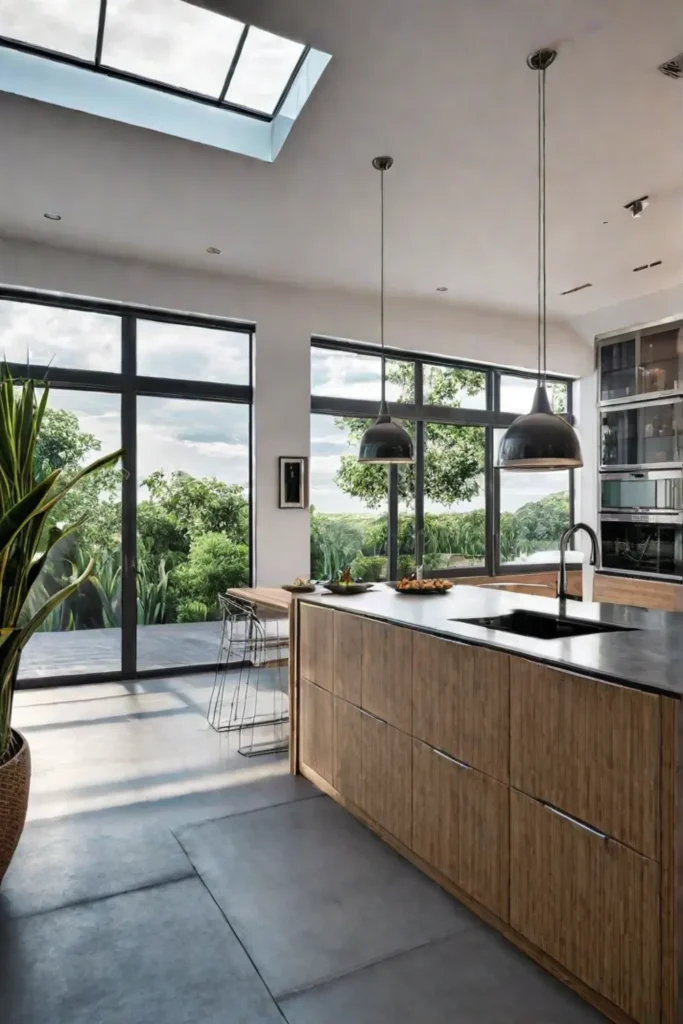
The Eco-Impact of Recycled Glass
One of the biggest environmental benefits of recycled glass is that it can be recycled endlessly without losing quality or purity. This closed-loop process conserves natural resources and reduces greenhouse gas emissions. Recycled glass countertops can contain up to 80% recycled content, significantly lowering their carbon footprint compared to virgin materials.
Designing with Recycled Glass
Recycled glass offers a stunning array of design possibilities for your kitchen renovation. Transform discarded bottles and jars into sleek, modern countertops that sparkle with vibrant colors and textures. Or create a showstopping backsplash with iridescent recycled glass tiles in shades of emerald, sapphire, and amber.
The non-porous surface of recycled glass is incredibly hygienic, stain-resistant, and easy to clean – ideal for the high-traffic kitchen. Incorporate recycled glass accessories like vases and storage jars to bring an eco-chic vibe to your space.
When sourced from a reputable manufacturer, recycled glass is just as durable and long-lasting as conventional materials. Many companies use innovative processes to fuse recycled glass with concrete or resins, creating solid surfaces suitable for kitchen countertops and floors.

Practical Tips
- Use recycled glass tiles in eye-catching hues to create a stunning, one-of-a-kind backsplash.
- Choose a recycled glass countertop for an ultra-modern look with unmatched depth and movement.
- Incorporate recycled glass vases, bowls, or storage containers as accent pieces.
- For a cohesive aesthetic, coordinate your recycled glass elements with warm wood tones and organic textures.
By embracing recycled glass in your kitchen design, you’re investing in both sustainability and style. Its unique beauty and eco-conscious origins will transform your space into a restorative sanctuary that honors the natural world.
Recycled glass offers a rare opportunity to turn trash into treasure while reducing your environmental footprint. What could be more beautiful than that?
Reclaimed wood is another brilliant material choice for bringing rustic charm and modern sustainability into your kitchen renovation. Let’s explore the timeless appeal of repurposed wood in the next section…
Reclaimed Wood: Rustic Charm, Modern Sustainability
In our quest for a more conscious, low-impact lifestyle, the materials we choose for our homes carry profound weight. Reclaimed wood beautifully embodies the sustainable values of cherishing our natural resources and embracing the stories of the past. By giving salvaged timber a new purpose, we reduce deforestation while infusing our kitchens with unparalleled warmth and character.

The Story Behind Reclaimed Wood
Every plank of reclaimed wood carries a unique history etched into its grain. Perhaps it was originally part of a 19th-century barn weathered by decades of New England winters. Or maybe it lined the floors of an industrial factory where generations of workers passed through. Some pieces may even bear the ocean-worn patina of shipwrecked wood. When incorporated into your kitchen design, these reclaimed elements become modern-day storytellers, reminding us of the interconnectedness of all things.
Bringing Reclaimed Wood into Your Kitchen
The versatility of reclaimed wood allows it to harmonize with any contemporary aesthetic. Create a warmly rustic ambiance with salvaged wood plank floors or ceiling beams. For a more refined look, incorporate reclaimed timber as a striking island countertop or open shelving to display your pottery and cookbooks. Accent pieces like reclaimed wood range hoods or craftsman-style cabinets add instant soul to the space.
When sourcing reclaimed wood locally, check for responsible suppliers who prioritize sustainable harvesting practices. While working with salvaged materials requires some additional preparation like de-nailing and sanding, the payoff is a one-of-a-kind kitchen imbued with unmatched personality.

By embracing reclaimed wood, we honor the past while forging a more thoughtful future. Its timeless beauty and sustainable origins transform our kitchens into nurturing spaces that restore our connection with nature.
In our next section, we’ll explore how low-VOC paints can further create a healthy, restorative ambiance by purifying the air we breathe at home.
Low-VOC Paint: Healthy Air, Healthy Home
In our quest for sustainable living, the air we breathe deserves just as much consideration as the materials we choose. Traditional paints release volatile organic compounds (VOCs) that can compromise indoor air quality, leading to respiratory issues and other health concerns. Low-VOC paints offer a simple yet powerful solution, allowing us to create beautiful, vibrant spaces without sacrificing our well-being.

Understanding VOCs and Their Impact
VOCs are carbon-based chemicals found in many household products, including conventional paints, varnishes, and solvents. When these compounds evaporate or off-gas, they introduce pollutants into the air we breathe, potentially causing headaches, dizziness, and long-term respiratory problems. By opting for low-VOC alternatives, we can significantly reduce our exposure to these harmful substances.
Choosing the Right Low-VOC Paint
The good news is that low-VOC paints have come a long way in recent years, offering a wide range of colors and finishes to suit any interior design style. When selecting your eco-friendly paint, look for third-party certifications such as Green Seal or Greenguard, which ensure the product meets strict standards for low VOC emissions.
Some reputable brands known for their eco-friendly paint options include:
- ECOS Paints
- Behr Premium Plus
- Benjamin Moore Natura
- Sherwin-Williams Harmony

While low-VOC paints may cost slightly more than conventional options, the investment is well worth it for the long-term benefits to your health and the environment.
To ensure optimal air quality during and after your kitchen renovation, follow these practical tips:
- Ensure proper ventilation by opening windows and using fans
- Allow the paint to fully cure before occupying the space
- Consider using a high-quality respirator mask during the application
By choosing low-VOC paint for your walls, cabinets, and furniture, you’re taking a significant step toward creating a healthier, more sustainable kitchen that nurtures both your family and the planet.
As we strive to reduce our environmental impact, the choices we make in our kitchens can have a profound effect. In the next section, we’ll explore the world of energy-efficient appliances, which not only conserve precious resources but also offer long-term cost savings for your home.
Energy-Efficient Appliances: Sustainable Savings for Your Kitchen
As conscious consumers, we understand that the choices we make at home have a far-reaching environmental impact. Upgrading to energy-efficient kitchen appliances is one of the most impactful ways to reduce your carbon footprint and utility costs. By investing in models certified by Energy Star, you’re committing to a more sustainable lifestyle without sacrificing performance or style.

The Benefits of Energy Star Appliances
Appliances bearing the Energy Star label meet strict efficiency guidelines set by the U.S. Environmental Protection Agency and Department of Energy. On average, Energy Star-certified products use 10-50% less energy and water than conventional models. This translates into significant savings on your monthly bills – an Energy Star refrigerator can save you over $300 in operating costs over its lifetime.
But the benefits extend far beyond your wallet. By choosing energy-efficient appliances, you’re reducing greenhouse gas emissions and conserving precious natural resources like water. It’s a simple yet powerful way to align your home with your eco-conscious values.
Choosing the Right Appliances
When shopping for new kitchen appliances, look for the Energy Star blue label. This signifies the model meets rigorous energy performance standards. Some top energy-saving picks include:
Refrigerators
Modern Energy Star refrigerators use about half the energy of 20-year-old models. Features like improved insulation and more efficient compressors make a big difference. Look for models with a freezer on top, as these tend to be more energy-efficient.

Dishwashers
Energy Star dishwashers are required to use less than 3.5 gallons of water per cycle. Many have smart sensors to optimize water usage and energy-saving cycles. Soil sensors can even detect how dirty dishes are to customize the cycle.
Induction Cooktops
Induction cooktops create a magnetic field to heat pots and pans directly, without wasting energy on the cooktop surface itself. This makes them over 80% more efficient than gas or electric coil cooktops.
Another eco-friendly perk – many utility companies offer rebates when you purchase Energy Star-rated appliances. Be sure to research any incentives in your area before upgrading.
By thoughtfully curating our kitchens with energy-efficient appliances, we can create beautiful, high-performance spaces in harmony with nature. It’s an investment that pays dividends – both financially and environmentally – for years to come.
Cork Flooring: Natural Comfort and Sustainability
Cork is a truly remarkable material that offers both beauty and sustainability for your kitchen flooring. Harvested from the bark of cork oak trees, it is a renewable resource that can be gathered without harming the trees themselves. These resilient trees can regrow their bark after harvesting, making cork an environmentally-friendly choice.

The Sustainable Story of Cork
What makes cork so special is its unique cellular structure. This natural composition gives it a soft, cushioned feel underfoot while also providing excellent insulation properties. Cork is also naturally antimicrobial, hypoallergenic, and resistant to mold and mildew, making it a healthy choice for your home.
Beyond its practical benefits, cork has an undeniable warmth and character that adds natural beauty to any space. With a range of colors and patterns available, you can find the perfect cork flooring to complement your kitchen’s design aesthetic.
Bringing Cork Flooring into Your Kitchen
Cork is an ideal flooring choice for kitchens, where you’ll be spending plenty of time standing and moving around. Its cushioned surface provides comfort and relief for your joints, reducing fatigue during meal preparation or cleanup.
Durability is another key advantage of cork flooring. When properly sealed and maintained, it can withstand heavy foot traffic and resist scratches, stains, and moisture. This makes it a practical choice for the high-activity environment of a kitchen.

To keep your cork floors looking their best, regular sweeping and occasional damp mopping is all that’s needed. Avoid harsh cleaners and excessive water, and your cork flooring will maintain its natural beauty for years to come.
As we transition to a more conscious way of living, cork flooring offers a sustainable and stylish solution for your contemporary kitchen renovation. Its natural warmth, comfort, and unique character create a welcoming ambiance that connects you to the beauty of the outdoors.
Salvaged and Upcycled Materials: Creative Reuse for a Unique Kitchen
In our modern world of excess and disposability, there’s something profoundly grounding about incorporating salvaged and upcycled elements into your home. By breathing new life into existing materials, you’re not only reducing waste but also imbuing your space with layers of history and soul. And what better room to embrace this sustainable philosophy than the heart of the home – the kitchen?

Finding Hidden Treasures: Sourcing Salvaged Materials
The hunt for salvaged treasures can be an adventure in itself. Start by exploring local architectural salvage yards, antique stores, and even online marketplaces for unique finds. Keep an open mind, as the most unassuming pieces can often be transformed into stunning kitchen features. An old barn door could become a striking pantry entrance, while a vintage window frame might make for an enchanting kitchen herb garden.
DIY Upcycling: Giving New Life to Old Pieces
For the true DIY enthusiast, upcycling offers a world of creative possibilities. Scour flea markets and thrift stores for hidden gems just waiting to be reimagined. An outdated dresser could be repurposed into a one-of-a-kind kitchen island, while a discarded metal headboard might find new life as a striking backsplash. The key is to let your imagination run wild and embrace the imperfections that give each piece its distinct character.

Remember, incorporating salvaged and upcycled materials isn’t just about sustainability – it’s also about infusing your kitchen with a sense of warmth and individuality. By thoughtfully repurposing existing objects, you’re creating a space that tells a story and reflects your unique journey. So go ahead, get creative, and let your kitchen become a canvas for your eco-conscious vision.
Final Thoughts
As we embrace a more intentional way of living, our homes become powerful reflections of the world we wish to create. By choosing sustainable, eco-friendly materials for your kitchen renovation, you’re investing in both the future of our planet and the well-being of your family. Each renewable element you incorporate – be it the organic serenity of bamboo or the timeless character of reclaimed wood – serves as a reminder that true luxury lies in cherishing our natural resources.

So let your kitchen become a sanctuary, a place where every surface, texture, and material connects you to the beauty of the outdoors. In doing so, you’ll not only create a stunning, contemporary space but also forge a deeper bond with the earth that sustains us. For in cultivating our homes with care and consciousness, we nourish far more than our bodies – we nourish our souls.
